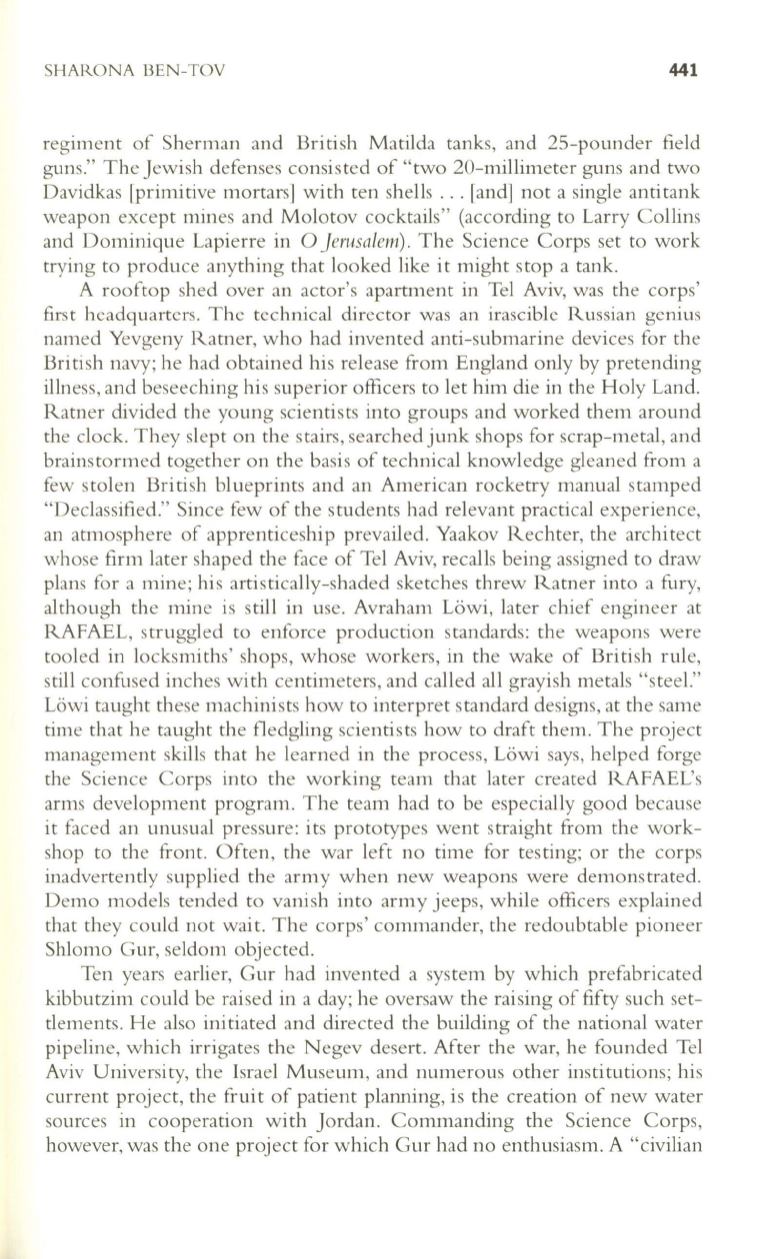
SHARONA 13EN-TOV
441
regiment of Sherman and British Matilda tanks, and 25-pounder field
guns." The Jewish defenses consisted of "two 20-millimeter guns and two
Davidkas [primitive mortars] with ten shells ... [and] not a single antitank
weapon except mines and Molotov cocktails" (according to Larry Collins
and Dominique Lapierre in
0
Jerusalem).
The Science Corps set to work
trying to produce anything that looked like it might stop a tank.
A rooftop shed over an actor's apartment in Tel Aviv, was the corps'
first headquarters. The technical director was an irascible Russian genius
named Yevgeny Ratner, who had invented anti-submarine devices for the
British navy; he had obtained his release from England only by pretending
illness, and beseeching his superior officers to let him die in the Holy Land.
Ratner divided the young scientists into groups and worked them around
the clock. They slept on the stairs, searched junk shops for scrap-metal, and
brainstormed together on the basis of technical knowledge gleaned from a
few stolen British blueprints and an American rocketry manual stamped
"Declassified." Since few of the students had relevant practical experience,
an atmosphere of apprenticeship prevailed. Yaakov Rechter, the architect
whose firm later shaped the face of Tel Aviv, recalls being assigned to draw
plans for a mine; his artistically-shaded sketches threw Ratner into a fury,
although the mine is still in use. Avraham Lowi, later chief engineer at
RAFAEL, struggled to enforce production standards: the weapons were
tooled in locksmi ths' shops, whose workers, in the wake of British rule,
still confused inches with centimeters, and called
all
grayish metals "steel."
Lowi taught these machinists how to interpret standard designs, at the same
time that he taught the fledgling scientists how to draft them. The project
management skills that he learned in the process, Lowi says, helped forge
the Science Corps into the working team that later created RAFAEL's
arms development program. The team had to be especially good because
it faced an unusual pressure: its prototypes went straight from the work–
shop to the front. Often, the war left no time for testing; or the corps
inadvertently supplied the army when new weapons were demonstrated.
Demo models tended to vanish into army jeeps, while officers explained
that they could not wait. The corps' commander, the redoubtable pioneer
Shlomo Gur, seldom objected.
Ten years earlier, Gur had invented a system by which prefabricated
kibbutzim could be raised in a day; he oversaw the raising of fifty such set–
tlements. He also initiated and directed the building of the national water
pipeline, which irrigates the Negev desert. After the war, he founded Tel
Aviv University, the Israel Museum, and numerous other institutions; his
current project, the fruit of patient planning, is the creation of new water
sources in cooperation with Jordan. Commanding the Science Corps,
however, was the one project for which Gur had no enthusiasm. A "civilian


